What Is the Inbound Methodology?The Proven Method for Sustainable Revenue Growth
The business landscape has changed dramatically in the digital era.
There was a time when salespeople used to be able to withhold details and sway prospects to make purchase decisions. Now, companies are no long gatekeepers of information.
There’s a reason marketers and salespeople earned a negative reputation in the before times predating the internet. They were able to be disruptive and control several aspects of the customer experience.
The shift toward a customer centric world is better for everyone involved.
People can educate themselves about their pain points, explore solutions, and make informed buying decisions. Brands can lead with helpful information, earning attention instead of stealing it. They can build trust and deliver a positive customer experience at every touchpoint of the buyer’s journey.
Outbound marketing tactics don’t get the results they used to. In fact, consumers hold little trust in marketers and salespeople. But why should they trust them?
This is why the inbound methodology is so effective today. It’s built for earning that trust and putting the customer first in every aspect of your business, most notably – inbound marketing.
Table of Contents
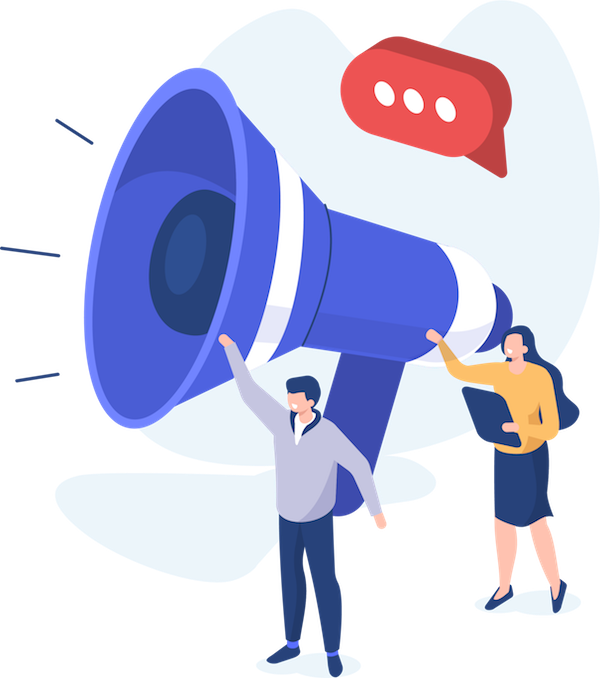
1What Is Inbound Marketing?
The term “inbound marketing” was coined in 2005 by HubSpot's co-founder and CEO, Brian Halligan. He was noticing a shift in consumer behavior. People were getting good at ignoring traditional outbound marketing tactics, like ads and cold calling.
The simplest way to describe the inbound marketing difference:
Market with a magnet, not a sledgehammer.
To effectively attract your target audience, you need to bring together content and context.
- Content: You gain traffic and build brand awareness by creating content that is optimized for search and social media.
- Context: You determine how your content guides your audience through the buyer’s journey and use that context to create a personalized experience.
To fully understand inbound, you should view it in three ways:
- Inbound as a Philosophy: The Why
- Inbound as a Methodology: The How
- Inbound as a Tool Set: The Playbook
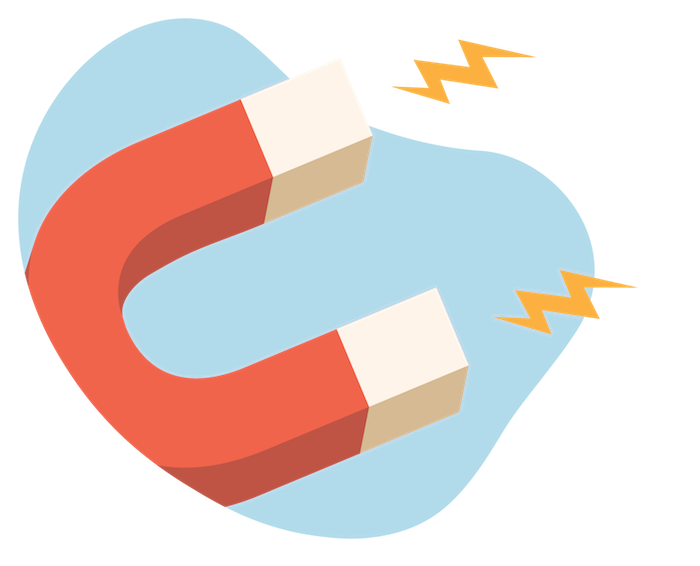
2The Philosophy: Why Inbound Works
The “why” behind the inbound methodology is actually very straightforward and simple.
Inbound emerged as a natural reaction to the evolution of consumer behaviors during the buying process. Before the internet paved the way for digital marketing, the buying experience was incredibly different.
- Buyers were not as informed.
- The buyer’s journey was linear.
- The marketing strategies tended to be interruptive.
In other words, being a consumer was pretty frustrating. You were getting bombarded with cold calls and other disruptions from marketers and advertisers. You didn’t have a lot of information about all the potential solutions for your primary concerns. And after you made a purchase, you were often an afterthought.
Now, in the digital age, people have gained access to more information than ever before. The modern buying experience has improved immensely for brands and consumers alike.
- Buyers have access to more information.
- The buyer’s journey is fluid and often starts in organic search.
- Thought leadership content is a better approach than interruptive tactics.
So why don’t these outdated marketing techniques work anymore?
Why Outbound Tactics Don’t Work Anymore
There are three key reasons why many outbound efforts are outdated.
The Media Landscape Continues to Grow.
Decades ago, marketers essentially relied on print materials (e.g., newspapers, brochures, catalogues) or radio advertisements. This dependence was mainly due to the fact that the media was contained. There were not a lot of options.
Cut to the modern media landscape, the amount of different channels and media formats is overwhelming. Not only are there so many different ways people can connect with brands, but there is also a lot of growth happening for these channels.
People can find highly targeted channels that align with their niche interests. A perfect example you can look at is the change in television. What went from a few channels on cable has grown to infinite options in satellite channels, digital television, and streaming services.
This presents a lot of opportunities for brands to find the right channels in today’s media landscape to develop brand awareness through inbound marketing efforts. It all comes down to learning where your audience spends their time and how you can effectively help them with memorable, informative content.
Marketers Earned a Bad Reputation.
Unfortunately, the marketing professionals of yesteryear adopted several deceitful tactics. Companies could simply overhype their products or services, making false claims and taking advantage of buyers who did not have access to the information they now use today.
One of the most common instances of deceptive marketing was seen during the 19th century in the United States, when entrepreneurs would promote snake oil as a cure-all elixir. The problem: These kinds of products were essentially useless oils that provided no health benefits whatsoever.
No wonder the general public is wary marketers and advertisers. This skepticism is a price companies still pay today as many brands continue to overpromise and underdeliver.
This new age of marketing calls for a lot of relationship building with audiences. People won’t just trust whatever mailer they receive or any blog they read. Brands need to do a lot to foster trust and earn credibility with their customers.
Technology Puts Information In Everyone’s Pockets.
Thanks to the advent of the internet and the massive surge in technological advancements, people can learn about brands, products, and services instantly with just a few clicks.
People are now equipped with an ability to find the help they need online, and they’re also keen on avoiding interruptive messages. They developed a natural instinct to block out disruptive marketing messages.
The Beginning of Inbound: Permission Marketing
The term “permission marketing” was coined by Seth Godin. He was referring to the concept of earning the permission of your audience for you to promote your products or services and continually engage with them. Permission and inbound marketing are often used interchangeably.
Essentially, permission marketing breaks down to a few steps:
- You attract people through content marketing by helping them solve problems.
- When they come to you, they’re more likely to trust you and convert on your website as a lead.
- Then, you’re able to nurture them and close them as new customers.
- Your teams can then focus on delighting customers so they can advocate for your brand.
There are many different themes that fall under the umbrella of permission-based inbound marketing, such as:
- Content marketing: Create targeted content that answers your audience’s questions and addresses their pain points.
- Lifecycle marketing: Provide contextual experiences for ideal buyers at each stage of their buyer’s journey.
- Personalized marketing: Leverage lead data to customize their experience and deliver tailored messages that address their unique needs.
- Omnichannel marketing: Execute tactics in each marketing channel in a way that caters to your audience’s preferred method of interaction.
- Account-based marketing: Marketing and sales teams identify high value accounts and collaborate to create personalized buying experiences.
In summary, through inbound marketing, you accomplish a few key goals that can drive business growth.
- Building trust with your ideal buyers.
- Being loved and getting repeat visitors.
- Outsmarting competitors through strategy.
When you understand why inbound marketing is the most valuable approach, you need to see the nitty gritty details in how it actually works.
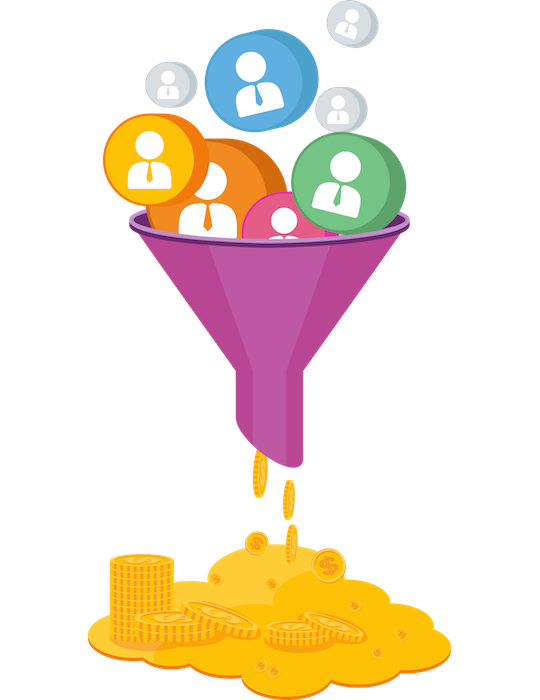
3The Methodology: How Inbound Works
The inbound methodology aligns with the buyer’s journey and guides people through each stage to eventually make a purchasing decision and become customers.
Essentially, people go from mere strangers on the internet who are looking for help to solve their problems to happy customers and even advocates for brands.
Here’s what the inbound methodology looks like:
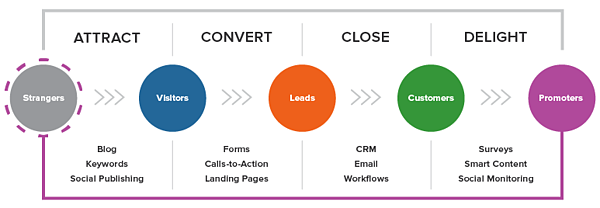
The Attract Phase: Getting Found By Your Target Audience
As you can see, your customer can find you in a variety of ways, like locating your blog on Google or discovering your brand on social media. They click through to your website and become your visitor.
The Convert Phase: Earning Information From Your Visitors
While they’re on your site, they’re finding helpful content that educates them on how to solve their biggest challenges. They eventually find a call to action (CTA) that resonates with them.
For example, they can subscribe to your newsletter or download your ebook. They provide their information by filling out a form on a landing page.
Now, your visitor converts into a lead.
The Close Phase: Nurturing Leads to Close Them as Customers
You can continually nurture leads and deliver awesome experiences. This might include progressive profiling, where you collect more lead intelligence over time. The more data you collect, the better your sales team can nurture them.
Your sales team, using the lead intelligence they have stored in the customer relationship management (CRM) system, can enroll leads into email workflows and eventually connect with them to close them as customers.
The Delight Phase: Turning Customers Into Advocates
Using customer service and support, you can set your new customer up to succeed and continually delight them. The better the customer experience, the more likely you are to retain and even upsell current customers.
Ideally, your customer is so happy that they share their positive experience with others, which drives referral business your way.
From Funnel to Flywheel
This entire inbound methodology was previously aligned with the traditional sales funnel, as seen here:
But this model includes a glaring issue: It doesn’t emphasize the importance of the customer. In fact, the customer feels like an afterthought once they’re closed.
Enter the flywheel framework.
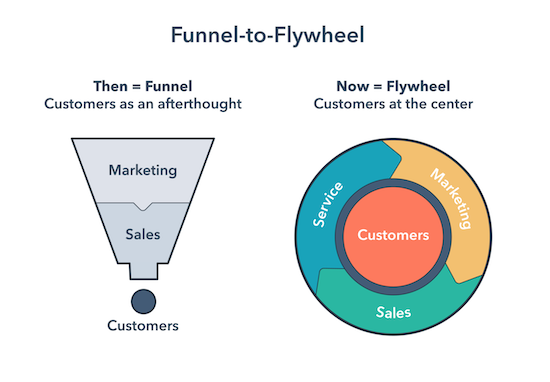
As you can see, the major difference between the outdated funnel and the current flywheel model is where the customer is located. The flywheel is inherently customer centric, meaning that all teams have the customer experience at top of mind.
This aligns perfectly with the inbound methodology:
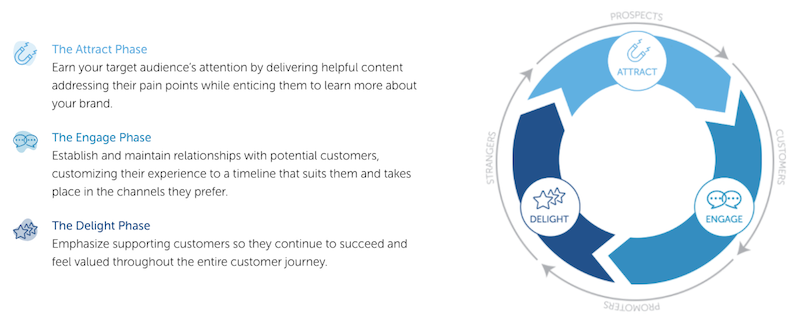
The best way to approach building and optimizing your flywheel is to focus on two priorities:
- Reducing friction: Address anything that slows down your flywheel, like misaligned teams or a lack of customer communication.
- Maximizing force: Implement strategies that increase the speed of your flywheel, like content marketing or customer referral programs.
This calls for a detailed examination of every team’s efforts, where you consider how the customer is impacted. Remember, your customers are human beings. They want to be treated like a person, not a number.
By applying inbound best practices and adopting a customer-centric philosophy throughout your organization, you’re demonstrating that you value your customers as people.
Delivering a positive customer experience that is consistent at every touchpoint throughout the lifecycle is how you increase revenue and ensure sustainable growth. To optimize your customer experience, you need to bring together inbound marketing, inbound sales, and inbound customer service.
Inbound Marketing
We already covered the definition of the inbound marketing methodology, which consists of the following three stages:
The Attract Stage
This is when you attract your target audience, which you define when you develop your buyer personas. Some of the most effective attracting strategies include:
- Executing an search engine optimization (SEO) strategy to get found by your target audience who are searching for help with their pain points.
- Writing and promoting helpful blog posts, like how-to guides that walk your buyer personas through a process that helps them solve a problem.
- Building communities through your social media channels and engaging with groups where your ideal buyers communicate.
The Engage Stage
Once you capture your target audience’s attention, you need to impress them while keeping them engaged with your brand. The best engaging strategies include:
- Creating enticing content offers to engage visitors and guide them to convert into leads.
- Nurturing your leads with email campaigns that deliver relevant content to continue helping them solve more problems.
- Using conversational marketing tools like live chat and chatbots to capture more information from your visitors and leads.
The Delight Stage
Marketing can have a hand in delighting your customers. Impactful delighting strategies that you can adopt include:
- Following a social media listening plan where you solicit feedback, field customer questions, and share real-life customer experiences.
- Leveraging chatbots to deliver customer surveys in an effort to gather feedback in an efficient manner.
- Creating memorable content experiences (e.g., informational videos) that your customers will want to share.
Inbound marketing is a vital component of the flywheel model, as you can see here:
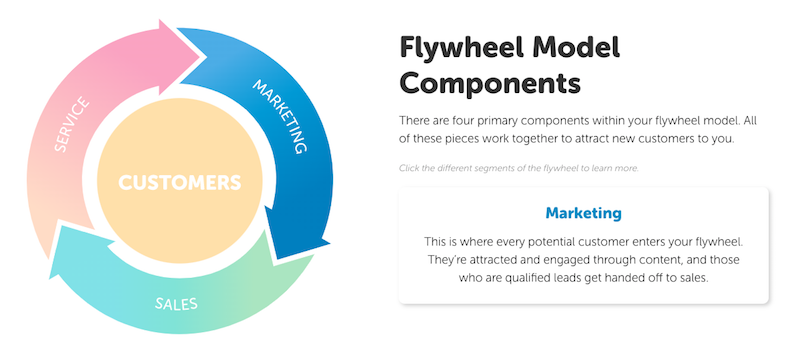
Inbound Sales
The inbound sales methodology puts the buyer first. It’s a consultative process where you support your lead though each step of the buyer’s journey.
Here’s how the inbound sales process aligns with the buyer’s journey:
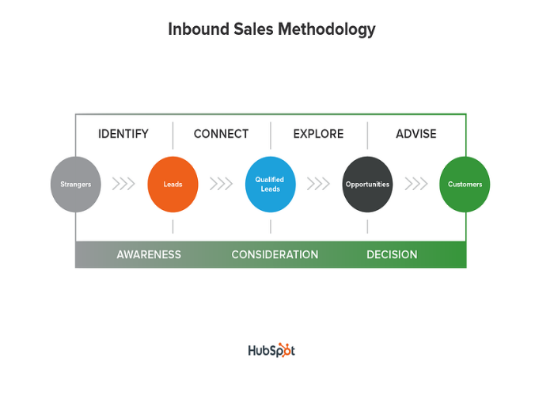
Let’s walk through each stage you need to cover in your inbound sales playbook:
The Identify Stage
This is when you identify leads within a pool of people to find the right opportunities. These leads are often delivered by your marketing team based on a set of sales lead qualifiers.
Lead qualifiers help your marketing team determine which leads will make ideal customers for your company, based on your target audience and buyer personas.
Define what would make a customer a good fit for your company, and always focus on active buyers instead of passive ones.
The Connect Stage
At this point, you’re ready to engage your leads, reaching out to help them identify a top challenge or goal that prospective customer needs to address. The purpose of this phase is ultimately to determine whether the lead has a goal or problem that you can help with.
There are plenty of different ways to connect with a lead, whether through email, outbound phone call (yes, outbound phone calls can still follow the inbound methodology), mutual connection, or even reaching out via platforms like LinkedIn.
Regardless of what method you choose, it’s important to focus on personalized outreach to the lead in order to start nurturing the relationship and build trust. Focus on understanding the buyer’s needs and how you can help.
The Explore Stage
Once you’ve established that the prospect has a goal or problem that you can help with, and they’ve expressed interest in allowing you to assist them, you can move on to the explore stage.
At this point, your sales team is working with qualified leads to determine how your company can help, and if your company’s products or services are the best fit for the lead’s goals or challenges.
This is when you need to ask more detailed questions to better understand what the lead is struggling with.
The Advise Stage
During this final stage, you’ll become a trusted advisor to the prospect. The ultimate goal here is to close the lead into a customer. This is accomplished when sales advises the prospective buyer on why their company’s solution aligns in a unique way to address immediate needs the prospect may have.
Your salesperson will need to express a thorough understanding of the prospect’s problem or goal, using knowledge that was collected during the connect and explore stages. This will allow them to better address the issue and explain how your offer can help the prospect with the problem.
This is how sales fits into the inbound organization, which is built using the flywheel framework.
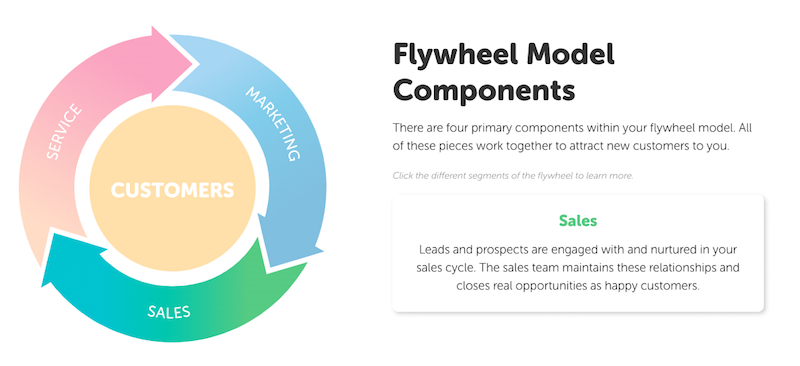
At the end of the buyer’s journey, the prospect makes their purchase and becomes a customer. Once they close, your company can continue to support their success through inbound customer service.
Inbound Customer Service
The inbound customer service methodology consists of how you attract, engage, and delight your customers to turn them into loyal advocates of your brand.
This framework consists of three different stages of the flywheel.
The Attract Stage
Attract prospective customers to your business with valuable resources and compelling testimonials from current customers. You can also consider building a robust knowledge base along with educational videos and blog posts that entice prospects to learn more.
There are a few action items you can take at this stage:
- Identify where customers feel lost or confused, then develop content resources that help them better understand the topic.
- Produce customer education materials for the whole content cycle of text, video, and audio.
- Ensure your knowledge base articles are ungated so they’re accessible.
- Leverage conversational marketing technology like AI chatbots and live chat.
The Engage Stage
Self-service resources will help many customers, but some will require a personal touch. For those who need a personalized approach to solve their problems, quickly triage and respond to incoming tickets.
Resolve issues quickly and effectively, in part by giving customers a selection of channels they can choose to reach you, like social media and live chat.
To better engage customers, you can follow these actionable tips:
- Use a help desk management system that provides a simple workflow so your service team can help customers with tickets fast.
- Identify metrics that align with your customer experience (e.g., retention rates, first response time) and monitor them.
- Use feedback responses to automate customer emails and trigger notifications for your internal team.
- Integrate all communication channels into your customer service dashboard so no customer query can be overlooked.
The Delight Stage
This is when you can turn your happy customers into vocal advocates for your brand. Responding to a customer service query in a way that dazzles your customers often produces win-win outcomes that wouldn’t have come about otherwise. This leads to positive reviews, referrals, and helpful feedback.
Some actions your team can take at this stage include the following:
- Deliver customer service surveys on a consistent basis to capture areas for improvement and identify your best strengths as a team.
- Establish a customer loyalty program that provides rewards and incentives to increase retention.
- Synthesize all your customer interactions into a clear overall view using your CRM suite.
- Follow up in a proactive way to verify customers are delighted and have no further concerns.
In the context of building an inbound organization, this is how inbound service fits into the flywheel.
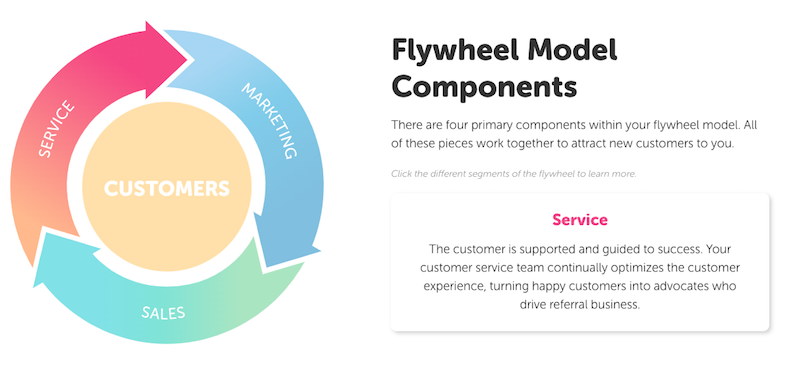
When you focus on optimizing your flywheel in each segment, you’re unifying all your teams around a common goal: attracting, engaging, and delighting your customers to create sustainable revenue generation. This is what a successful inbound organization can accomplish.
But you can’t get this done without the right tools at your disposal.
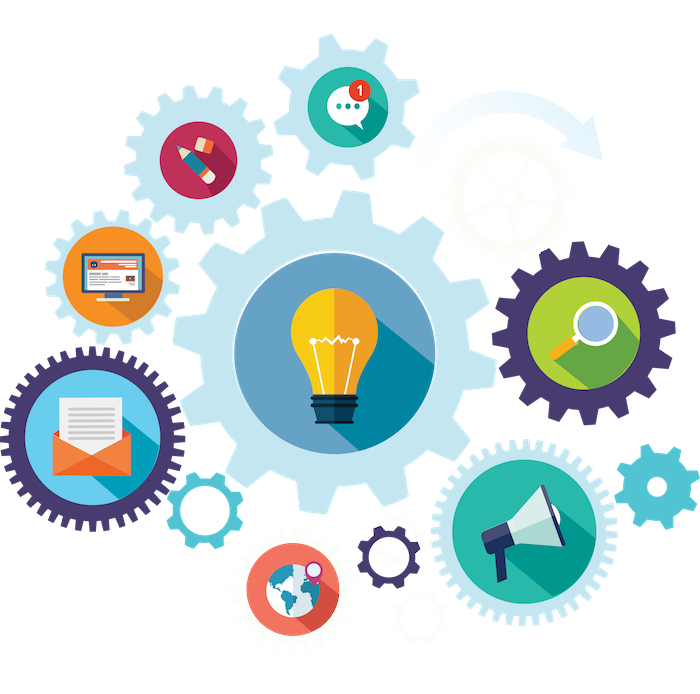
4The Tools: An Inbound Playbook That Works
Each stage of your inbound strategy requires a set of resources and software that enables your team to deliver an awesome customer experience.
Step 1: Attracting Strangers and Turning Them Into Website Visitors
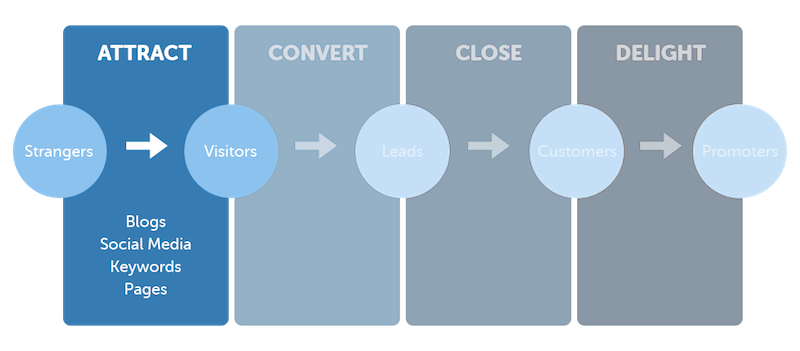
This is where content marketing is vital.
70 percent of marketers are actively investing in content marketing (HubSpot).
First, you need to know who your ideal buyers are, along with their key characteristics. You can accomplish this by developing buyer personas.
Buyer personas are a semi-fictional representation of your ideal customer. The true objective here is to base this off of market research and real data about your existing customers so you can accurately market to these people.
Your buyer personas need to be distributed and used by everyone in your company. Most notably, marketing and sales use them on a regular basis.
How Marketing Uses Buyer Personas
- Develop targeted content ideas that are relevant to the personas’ pain points.
- Create lead magnets that entice your audience to convert into leads.
- Identify the best channels for promoting content and building communities.
How Sales Uses Buyer Personas
- Start a relationship with prospects in an informed, proactive manner.
- Nurture relationships by better educating and supporting them.
- Earn trust and build credibility with ongoing consultations.
Buyer personas save your marketing and sales teams a lot of time and inform their efforts so your strategies are more effective and efficient. By understanding the nature of your target audience, you can optimize your touchpoints by delivering personalized experiences that cater to all your audience segments.
Marketers today create content for several audience segments. Marketing to three audience segments is most common (HubSpot).
One of the most important experiences you create is your business blog. When you know exactly what your ideal buyers need, you can create and promote content that helps them find specific solutions.
A major component of blogging is search engine optimization (SEO). Optimizing content is essential because of how prevalent search engines are in our daily lives.
About 64 percent of marketers actively invest time in search engine optimization. (HubSpot).
In the context of marketing, search is the number one traffic source to blogs across all industries. You develop content that is optimized to rank for search queries that your ideal buyers are using. With ongoing efforts, you can be the first resource they come across as they search for information online.
In other words, an effective SEO strategy gets your brand in front of the right people who are searching for topics related to your business. But search engines are not the only channel to include in your inbound marketing.
You also need social media channels to promote your content and attract followers within social media communities. No matter your industry, you have potential buyers congregating on social platforms and communicating about problems your business can help solve.
But as you’re driving more traffic to your website, you need to consider how people will use your site to find information. Website optimization is how you build and maintain a positive user experience.
When people enjoy coming to your site, they come back. Even better, they tell friends about it, or share your content to their social media followers.
As more traffic comes in, you can start to earn people’s trust and convert them into leads.
Attract Stage Tools You Need
- Content management system (CMS)
- Keyword research tool
- Social media management tool
- Website analytics platform
Step 2: Converting Website Visitors Into Leads
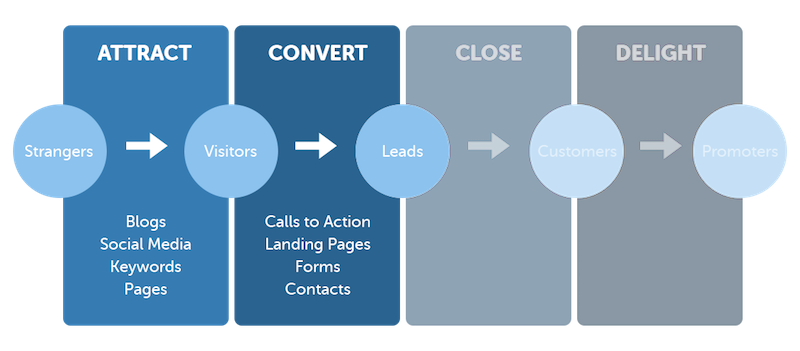
At this stage, it’s time for your lead generation strategy to shine. Effective lead generation consists of a few moving parts that make up a conversion path.
This is what a typical conversion path looks like:
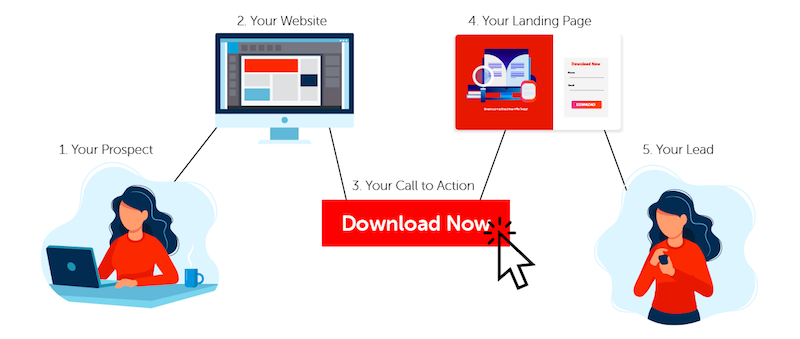
Here are the components that you need to develop a comprehensive conversion path and effective lead generation strategy:
- Calls to action (CTAs) on your website to send people to landing pages.
- Landing pages to entice your visitors to download a content offer.
- A content offer (or lead magnet) that your audience wants to download to solve a pain point.
- A form for visitors to submit their information and become a lead in your pipeline.
- A customer relationship management (CRM) platform to keep your contacts database up to date.
The top priority for marketers is generating leads (HubSpot).
Let’s walk through an example of how to create a conversion path for your lead generation strategy.
An Example from Bluleadz: Conversion Path Planning
Our content team brainstormed using our buyer personas to identify an impactful content offer, specifically something that Sales Manager Steve would want to download. We outlined, researched, wrote, and designed an interactive workbook, the Inbound Sales Playbook.
Once the campaign was built in the HubSpot Marketing Hub, our content team pulled a list of high performing blog posts that Sales Manager Steve would likely seek out.
For example, the post “5 Sales Reports You Need to Get From Your Sales Team” was written for Steve. He would likely find this post while researching sales reports, which is another one of his areas of focus.
We created a CTA button for this content offer and placed it at the end of the blog post to entice readers to learn more about the process of inbound sales and how to adopt it with their team.
Readers click the CTA and go to the landing page, where they fill out the form to download their ebook. Once the reader submits the form, their contact information is stored in our HubSpot CRM. This is how you generate leads and collect lead intelligence using inbound tactics.
The more lead data you can get, the better equipped your sales team is to nurture and close them into customers.
Convert Stage Tools You Need
- CTA creation software
- Landing page creation software
- Design software
- Form creation tools
- Customer relationship management (CRM) platform
Step 3: Closing Leads Into Customers Through Lead Nurturing
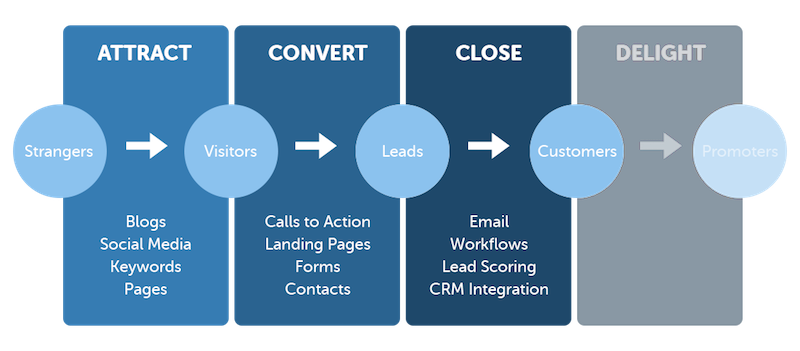
Inbound sales is the best approach for nurturing leads and closing deals faster. There are several components you need throughout your inbound sales strategy, including:
- Lead scoring to prioritize your best opportunities.
- Email to connect with and engage your leads.
- Automation to add personalization and context.
- Sales enablement tools to streamline day-to-day operations and give your sales team more time to actually sell to leads and not drown in manual labor.
- Reporting to attribute the closed deals to marketing and sales efforts.
Without the right tools, you’re burying your sales team with menial tasks. Companies that still use spreadsheets are losing so much time as they manually enter data. And worse, they’re risking losing essential customer data.
Your sales team needs the right software to enable them to organize and access all their lead data to prioritize and plan their outreach. They also need accurate reporting to see their individual performance as well as their team’s performance.
Simply put, when teams don't have the right tools, reps are losing a lot of time. Automation and other software tools add hours to their day so they can focus more on selling and less on menial tasks or recovering lost customer data.
On average, nearly two-thirds (64.8 percent) of reps’ time is spent on non-revenue-generating activities (Forbes).
As you close more customers, you can delight them through excellent customer service and turn them into brand advocates.
Close Stage Tools You Need
- Lead scoring
- Marketing automation
- Email software
- Closed loop reporting
- Pipeline management
Step 4: Delighting Customers to Turn Them Into Promoters
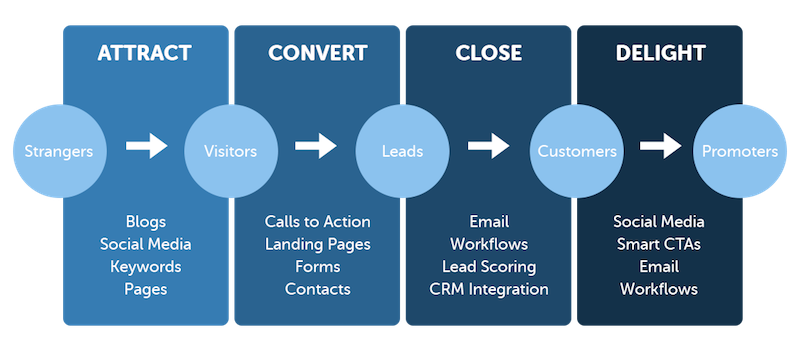
This is where your customer experience strategy comes in handy, and it should be influenced by the inbound customer service methodology. When you adopt inbound service tactics, you’re able to truly go above and beyond to support the success of your customers.
86 percent of buyers are willing to pay more for a great customer experience (PWC).
Some of the most important elements you need in your customer experience strategy include the following:
- A help desk platform to field customer inquiries.
- A knowledge base and chatbots for customers to self-solve their issues.
- Survey tools to gather customer feedback to improve the customer experience.
The better customer service you provide and the more you cater to their preferences, the more likely they are to stay loyal to your brand. And brand loyalty is huge for your business.
When you develop trust and loyalty, customers want to come back to buy more. They want to share your content. They want to refer their friends to you. They want to leave positive reviews.
72 percent of customers will share a positive experience with six or more people (Esteban Kolsky).
All of this comes together to really boost your revenue over the course of your entire lifetime with your customers. Simply put, happy customers are the life force of sustainable revenue growth.
Customer delight pays dividends as you build a loyal following and start to stand out as the go-to resource in your industry.
Delight Stage Tools You Need
- Help desk software
- Knowledge base platform
- Live chat and chatbot tools
- Customer service software
How Inbound and Software Come Together
That’s a robust toolkit you need to execute a successful inbound strategy. While there are plenty of options to choose from, there’s one solution that brings them all together in one place.
Here’s a breakdown of all the HubSpot tools you need for each team at each step of your inbound strategy.
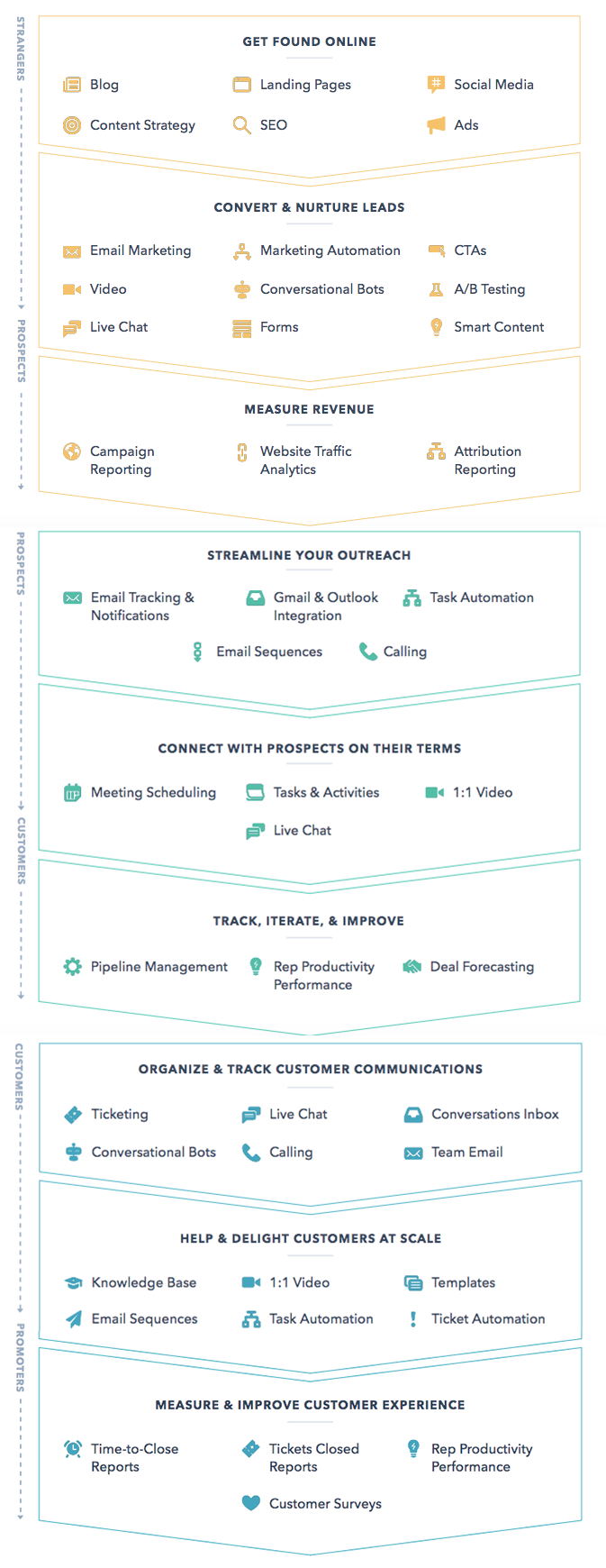
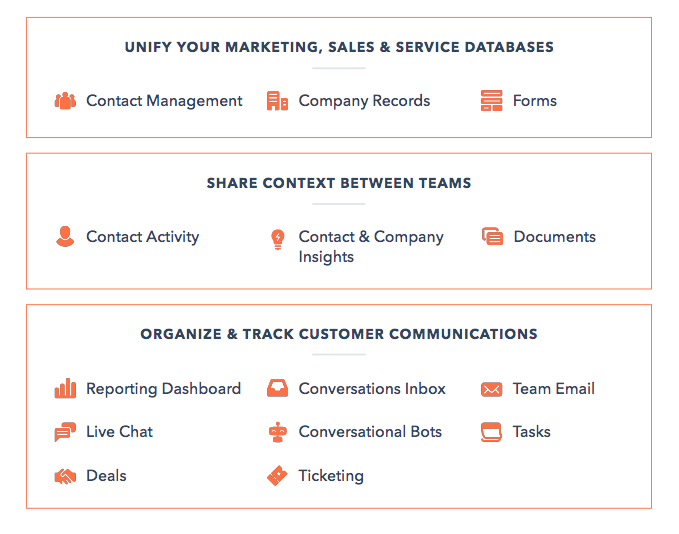
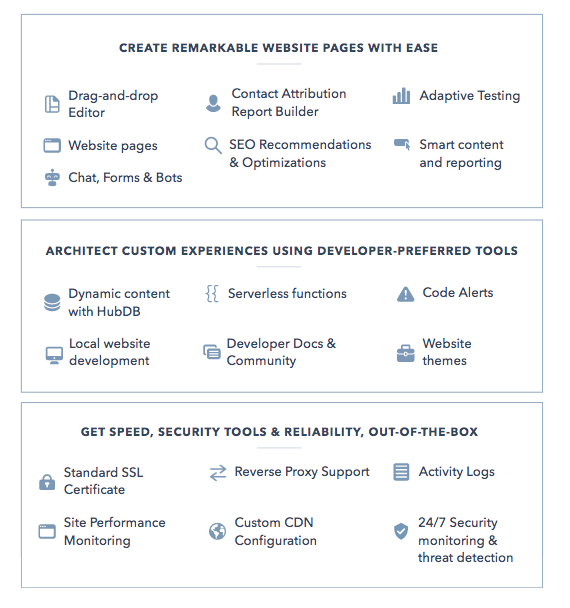
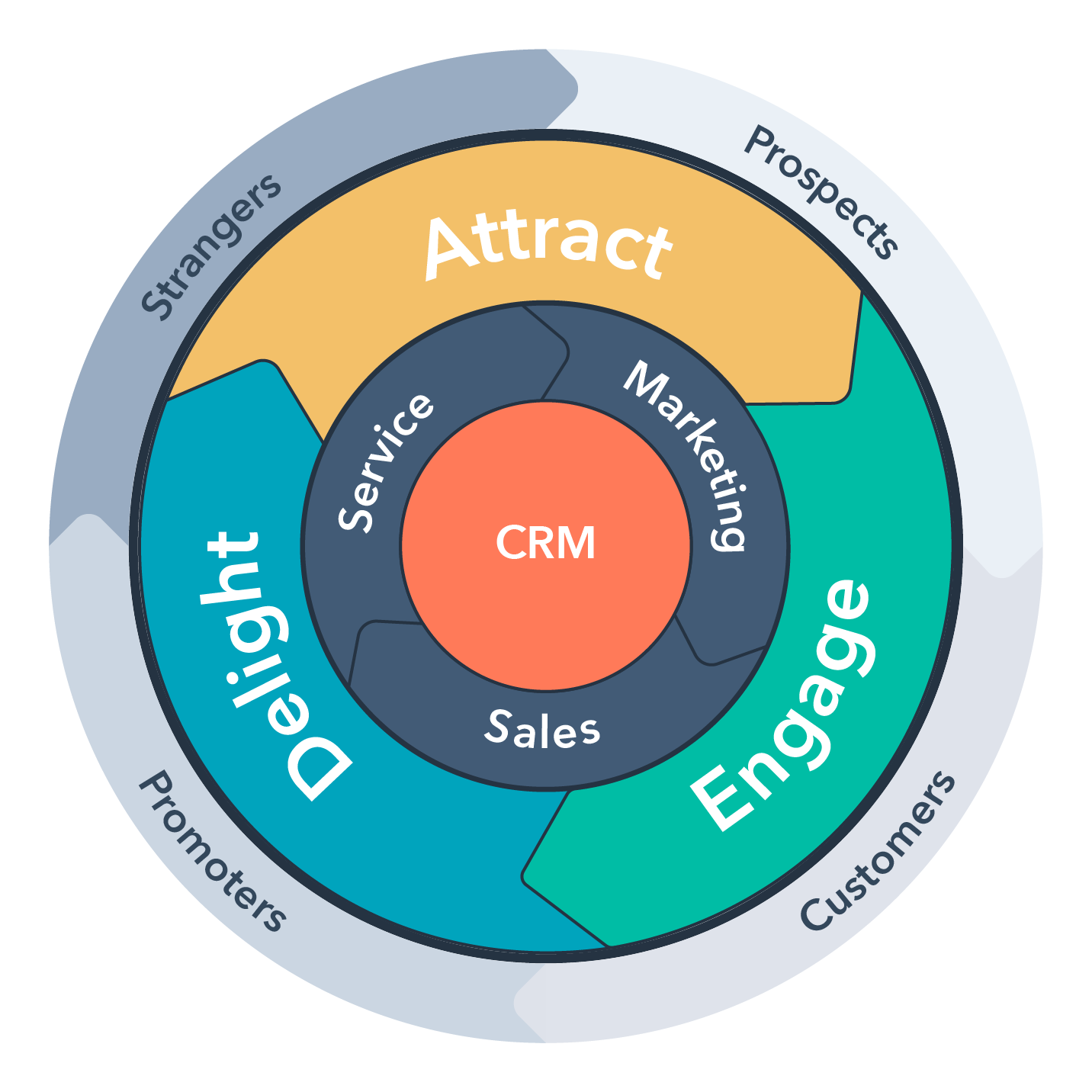
5How to Stay Educated on Inbound
As with all marketing, sales, and customer service, you need to constantly stay in the know on how the world of inbound is evolving and how the customer experience is changing.
Here’s a list of resources to keep you on top of it.
The Best Blogs on Inbound, Marketing, and More
- HubSpot
- Bluleadz
- Moz
- Ahrefs
- Ann Handley
- Jeff Bullas
- Search Engine Journal
- Content Marketing Institute
Subscribe to these blogs to continue learning on a daily basis. When you stay informed regularly and commit to educating yourself, you will outperform your competitors and crush your business goals.
